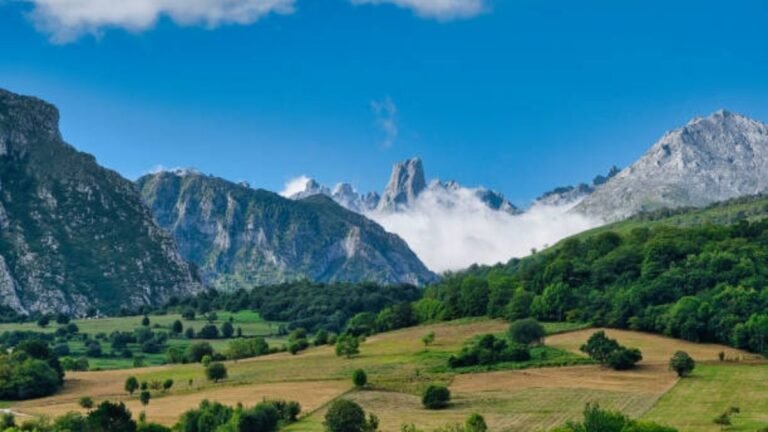The Cantabrian Mountains, a majestic range that stretches across northern Spain, are renowned for their stunning landscapes, rich biodiversity, and unique cultural heritage. Whether you’re a seasoned traveler, an outdoor enthusiast, or someone interested in the geographical beauty of Spain, understanding what the Cantabrian Mountains are known for will deepen your appreciation for this fascinating region. This article will explore the features that make the Cantabrian Mountains stand out, touching on their natural beauty, ecological importance, historical significance, and role in Spanish culture.
Introduction: The Cantabrian Mountains at a Glance
The Cantabrian Mountains (Montes Cantábricos) form a natural barrier between the northern coast of Spain and the central plateau. Extending from Galicia in the west to the Basque Country in the east, these mountains are renowned for their rugged terrain, picturesque valleys, and high-altitude peaks. With a total length of approximately 600 kilometers, the Cantabrian range includes some of Spain’s most dramatic and diverse landscapes.
In this article, we will explore what the Cantabrian Mountains are known for, delving into the key aspects that make them a must-visit destination for nature lovers, hikers, and anyone fascinated by Spain’s topography and cultural history.
The Geography and Landscape of the Cantabrian Mountains
The Cantabrian Mountains are often described as a series of steep, jagged peaks and deep valleys. They represent the transition from the northern coastal regions to the vast plateau of central Spain. The mountain range is part of the larger Pyrenean system, which includes other notable mountains like the Pyrenees themselves. However, the Cantabrian range has its own distinct characteristics, such as its lush green valleys, spectacular cliffs, and alpine meadows.
Key Features of the Cantabrian Landscape:
- High Peaks: The Cantabrian Mountains are home to numerous high peaks, with the highest being Torre de Cerredo, which reaches 2,648 meters above sea level. Other significant peaks include Peña Ubiña (2,417 meters) and the Picos de Europa range, known for its breathtaking beauty.
- Verdant Valleys: The region is famous for its green valleys, largely due to the abundant rainfall brought by the proximity of the Bay of Biscay. The valleys such as the Valdeón and the Sella are lush and perfect for outdoor activities.
- Lakes and Rivers: The Cantabrian Mountains are dotted with pristine lakes, including the famous Lakes of Covadonga in Asturias. The mountain range is also home to many rivers, such as the Sella River, which are popular for kayaking and fishing.
-
Rich Biodiversity: Flora and Fauna of the Cantabrian Mountains
The Cantabrian Mountains are a biodiversity hotspot. Their unique geography, combined with a range of microclimates, creates an environment where both plant and animal life thrive. The mountains are particularly important in the context of European conservation efforts, as they harbor species that are rare or endangered elsewhere in Europe.
Flora
The flora of the Cantabrian Mountains is incredibly diverse. The lowland areas are covered with oak forests, while the higher altitudes feature lush, temperate forest ecosystems. You’ll find a mix of deciduous and coniferous trees, such as:
- Beeches and Oaks: These trees are common in the lower valleys, where the climate is mild and humid.
- Pines and Fir Trees: In the higher altitudes, especially in areas with less moisture, pines and firs dominate the landscape.
- Wildflowers and Alpine Plants: The alpine meadows are home to a stunning array of wildflowers, including species of orchids and gentians that bloom during the summer months.
Fauna
The fauna of the Cantabrian Mountains is equally impressive. A variety of mammal species, birds, and reptiles make their home in this region. Some notable animals found in the Cantabrian Mountains include:
- Cantabrian Brown Bear: A rare and protected species, the Cantabrian brown bear is one of the most iconic animals in the region. These bears are a symbol of conservation efforts in Spain and can be found in remote areas of the mountains.
- Iberian Wolf: Another endangered species, the Iberian wolf roams parts of the Cantabrian Mountains, and it is a key focus of wildlife conservation in the region.
- Golden Eagle and Griffon Vulture: These majestic birds of prey are commonly seen soaring above the mountain cliffs, taking advantage of the thermals created by the rugged landscape.
-
Cultural Significance: What the Cantabrian Mountains are Known for
Beyond their natural beauty, the Cantabrian Mountains also play a significant role in the cultural and historical identity of northern Spain. The region is rich in traditions, folklore, and local history, making it a fascinating destination for those interested in Spain’s cultural heritage.
Traditional Villages and Architecture
The villages nestled in the Cantabrian Mountains are steeped in tradition. The stone houses, winding streets, and ancient churches offer visitors a glimpse into the past. Some towns, such as Potes in Cantabria and Cangas de Onís in Asturias, are known for their picturesque setting and historic charm.
Festivals and Traditions
The Cantabrian region is also known for its vibrant festivals, many of which celebrate its natural beauty and rural traditions. The Fiesta de la Virgen de la Cueva in Covadonga, Asturias, is a key religious and cultural event. Similarly, the Fiesta de la Montaña celebrates the region’s mountain heritage and is marked by music, dance, and traditional foods.
Gastronomy
The culinary culture of the Cantabrian Mountains is another key aspect of the region’s appeal. The mountains are famous for their local cheeses, such as Queso de Cabrales (a blue cheese made from cow, sheep, or goat milk), as well as hearty stews and dishes made from locally sourced meats. The coastal areas also contribute to the region’s culinary identity with a rich selection of seafood dishes.
-
Outdoor Activities: What the Cantabrian Mountains Are Known For
For adventurers, the Cantabrian Mountains are a paradise. The rugged terrain and natural beauty make the region ideal for a wide range of outdoor activities.
Hiking and Trekking
The Cantabrian Mountains are home to numerous hiking trails, ranging from easy walks through forests to challenging climbs up steep peaks. The Picos de Europa National Park offers some of the most spectacular trekking routes in Spain. Popular hikes include the Cares Gorge Trail, a dramatic route that follows the Cares River through narrow gorges and past towering cliffs.
Mountain Climbing
For experienced mountaineers, the Cantabrian Mountains offer some serious climbing challenges. The Picos de Europa are famous for their alpine terrain and steep rock faces, providing both technical climbs and thrilling summit views. The Torre de Cerredo peak is a particular highlight for climbers looking for a challenging ascent.
Skiing and Snowboarding
In the winter, the Cantabrian Mountains transform into a haven for winter sports enthusiasts. Ski resorts like San Isidro in León and Valgrande-Pajares in Asturias offer excellent skiing conditions, particularly for those who prefer less crowded slopes compared to more famous European resorts.
-
The Cantabrian Mountains in Comparison to Other European Mountain Ranges
To provide a broader context, it’s helpful to compare the Cantabrian Mountains with other well-known European mountain ranges. The following chart highlights key differences and similarities between the Cantabrian Mountains and the Pyrenees, a nearby range that also plays a significant role in Spanish geography.
| Feature | Cantabrian Mountains | Pyrenees Mountains |
| Location | Northern Spain (Asturias, Cantabria, León, and parts of Castile and León) | Border between Spain and France, stretching from the Mediterranean to the Atlantic Ocean |
| Highest Peak | Torre de Cerredo (2,648 meters) | Aneto (3,404 meters) |
| Notable National Parks | Picos de Europa National Park | Ordesa y Monte Perdido National Park |
| Climate | Maritime climate, wet and mild | Alpine climate, with more extreme temperatures |
| Main Activities | Hiking, trekking, mountain climbing, skiing | Hiking, skiing, mountaineering, cross-country skiing |
As seen in the chart, while the Cantabrian Mountains share some similarities with the Pyrenees in terms of outdoor activities and natural beauty, they stand apart due to their distinct location, climate, and the particular species and cultures they nurture.
Conclusion: Why the Cantabrian Mountains Are Known For Their Unique Charm
The Cantabrian Mountains are known for their diverse landscapes, rich biodiversity, and deep cultural heritage. Whether you’re drawn to their towering peaks, lush valleys, or the traditional villages that dot their slopes, there’s something in this range for everyone. From hiking through rugged terrain to exploring its fascinating wildlife and rich history, the Cantabrian Mountains offer a truly immersive experience.
Their combination of natural beauty and cultural significance makes the Cantabrian Mountains an integral part of Spain’s identity. Whether you’re an avid adventurer or someone interested in the history and culture of northern Spain, this mountain range provides endless opportunities for discovery and awe.
Key Takeaways:
- The Cantabrian Mountains are known for their stunning natural beauty, with dramatic peaks, verdant valleys, and pristine rivers.
- The range is home to unique wildlife, including the Cantabrian brown bear and the Iberian wolf.
- Rich in cultural traditions, the region is famous for its quaint villages, historic architecture, and vibrant festivals.
- Outdoor enthusiasts can enjoy hiking, mountain climbing, skiing, and more in this diverse landscape.
- The Cantabrian Mountains are often compared to other European ranges like the Pyrenees, but their unique characteristics make them a distinctive destination.
If you’re considering a trip to Spain, the Cantabrian Mountains are undoubtedly worth exploring, offering everything from adventure to cultural immersion.

